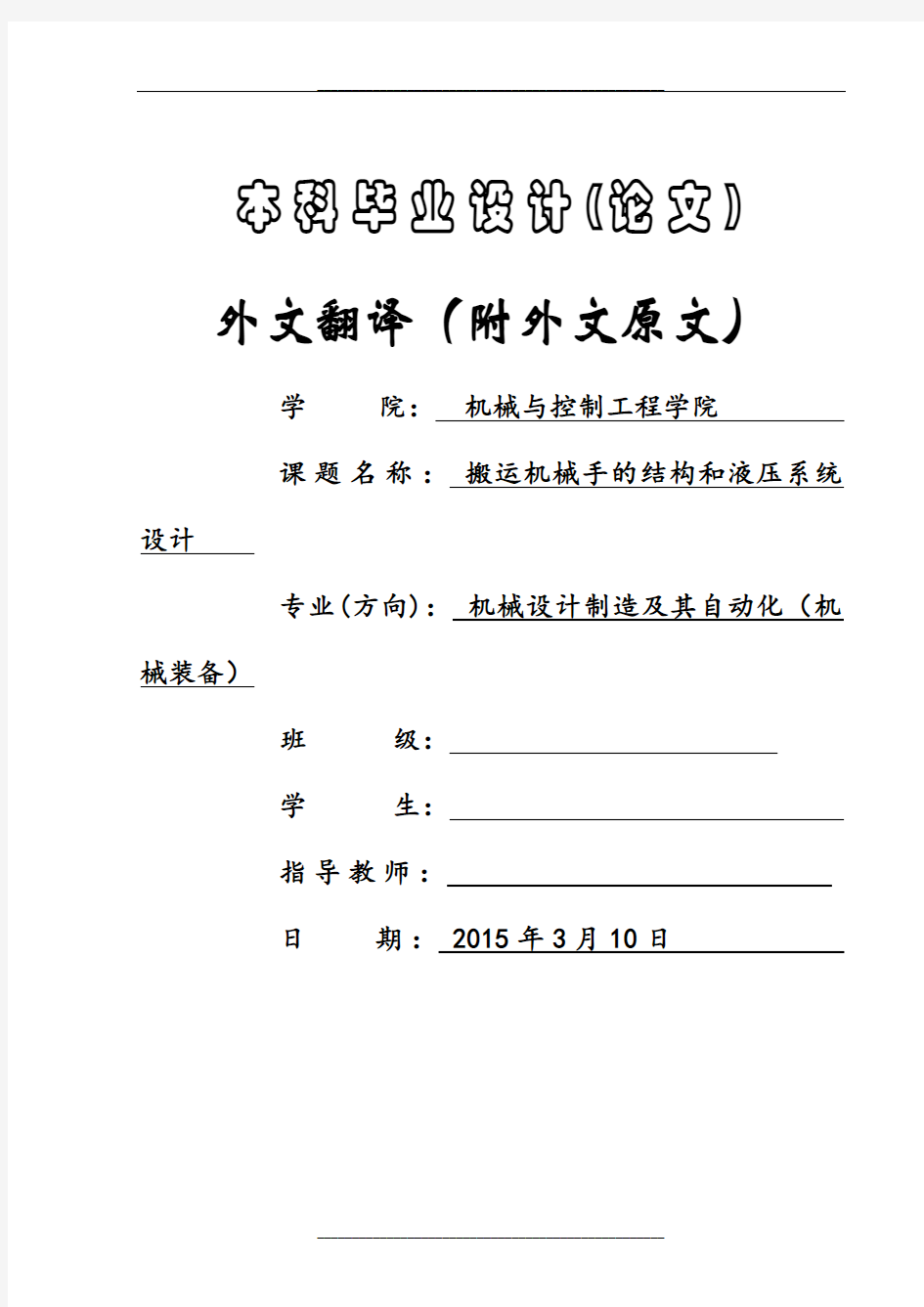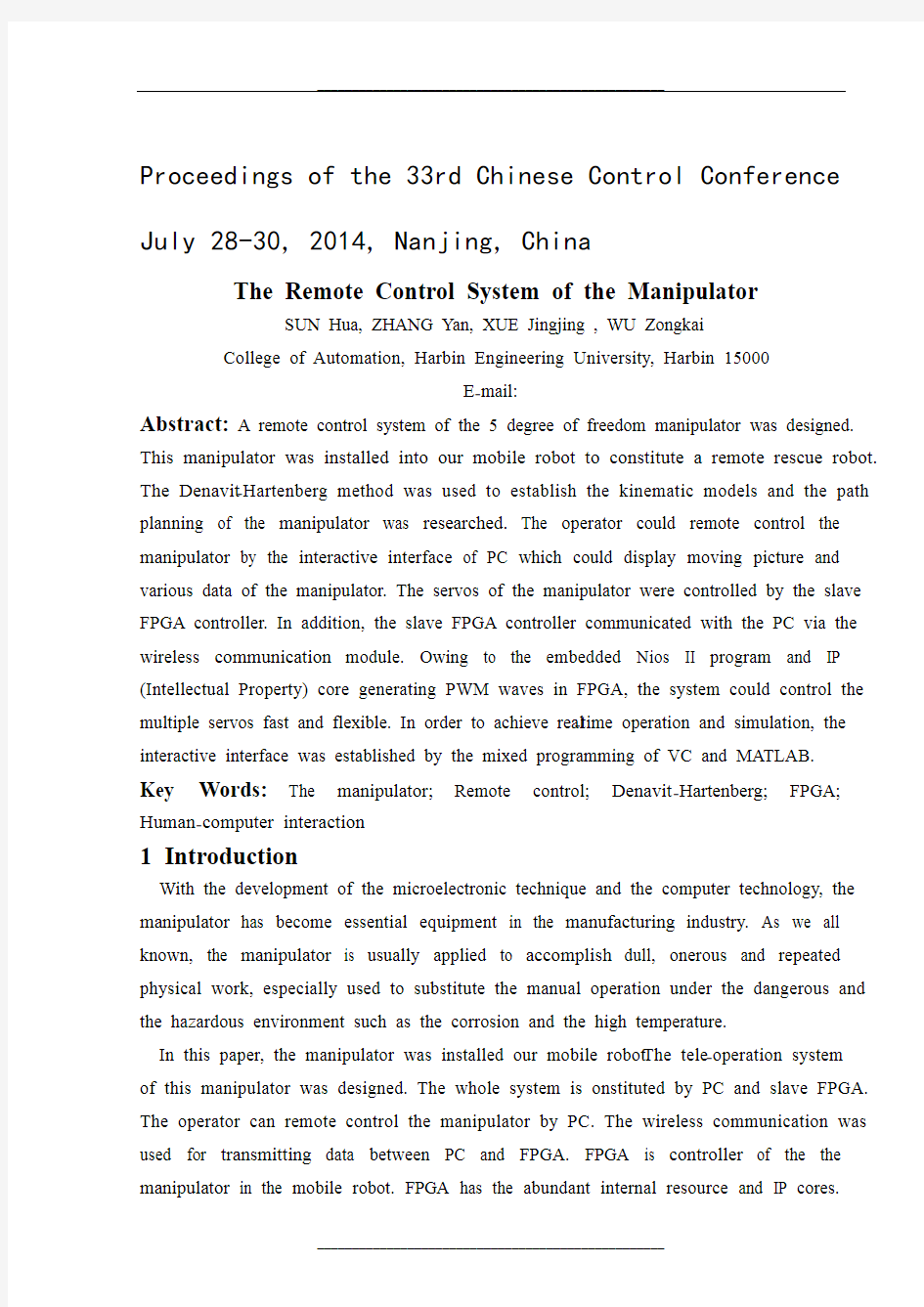机械手外文翻译


本科毕业设计(论文)
外文翻译(附外文原文)
学院:机械与控制工程学院
课题名称:搬运机械手的结构和液压系统设计
专业(方向):机械设计制造及其自动化(机械装备)
班级:
学生:
指导教师:
日期: 2015年3月10日
Proceedings of the 33rd Chinese Control Conference July 28-30, 2014, Nanjing, China
The Remote Control System of the Manipulator
SUN Hua, ZHANG Yan, XUE Jingjing , WU Zongkai
College of Automation, Harbin Engineering University, Harbin 15000
E-mail:
Abstract: A remote control system of the 5 degree of freedom manipulator was designed. This manipulator was installed into our mobile robot to constitute a remote rescue robot. The Denavit-Hartenberg method was used to establish the kinematic models and the path planning of the manipulator was researched. The operator could remote control the manipulator by the interactive interface of PC which could display moving picture and various data of the manipulator. The servos of the manipulator were controlled by the slave FPGA controller. In addition, the slave FPGA controller communicated with the PC via the wireless communication module. Owing to the embedded Nios II program and IP (Intellectual Property) core generating PWM waves in FPGA, the system could control the multiple servos fast and flexible. In order to achieve real-time operation and simulation, the interactive interface was established by the mixed programming of VC and MATLAB. Key Words:The manipulator; Remote control; Denavit-Hartenberg; FPGA; Human-computer interaction
1 Introduction
With the development of the microelectronic technique and the computer technology, the manipulator has become essential equipment in the manufacturing industry. As we all known, the manipulator is usually applied to accomplish dull, onerous and repeated physical work, especially used to substitute the manual operation under the dangerous and the hazardous environment such as the corrosion and the high temperature.
In this paper, the manipulator was installed our mobile robot. The tele-operation system of this manipulator was designed. The whole system is onstituted by PC and slave FPGA. The operator can remote control the manipulator by PC. The wireless communication was used for transmitting data between PC and FPGA. FPGA is controller of the the manipulator in the mobile robot. FPGA has the abundant internal resource and IP cores.
And a central control option was built via an embedded Nios II program and an IP core in FPGA. Furthermore, Verilog language was adopted to design the IP core which generated digital PWM waves for controlling the manipulator. Therefore, this system could reach higher precision and easy to debug.
MATLAB software was adopted to build the kinematic models of manipulator. And using D-H (the acronym of Denavit-Hartenberg) method to solve the forward and inverse kinematic equations of the manipulator, to analyze the motivation, to plan and track the motion’s path.
In addition, a good interface of human-computer interaction was enhanced in the remote control system of the manipulator in PC. Moreover, the manipulator simulation technology was built by using the mixed programming of VC and MATLAB. Thus, the motion choreographs was got quickly and easily, also greatly saved time and cut the cost.
2 Manipulator Model and Path Planning
At first, the motion model of the manipulator was built. Then, the kinematic simulation and its path planning were researched. These works provided the foundation for the design of the remote control system of the manipulator.
2.1 Motion Model of the Manipulator
The manipulator was regarded as an open loop kinematic chain. It was constituted by five rotary joints. And its one end was fixed on a base while the other end was used to achieve the ability of grabbing. Therefore, it is better to establish a chain coordinate frame as shown in Fig.1. The terminal position and attitude was determined via using forward kinematic equation after knowing the rotating angle of every joint. The D-H parameter table shown as Table 1 was established by using the frames in Fig.1.
Fig.1 Coordinate frames of mechanical arm
Table 1 D -H Parameters of the Robot Arm
Due to D -H method:
T =A n+1n+1n =(Cθn+1?Sθn+1Sθn+1Ca n Cθn+1Ca n 0a n ?Sa n ?Sa n d n+1Sθn+1Sa n Cθn+1Sa n 00Ca n Ca n d n+101
) Where Cθn+1=cos θn+1 , Sθn+1=sin θn+1 , Ca n =cos a n , S a n =sin a n . The transformation matrix of every joint was given by equation (2).
T 10=(cos θ1sin θ1sin θ1cos θ100000000
1001) T 21=(cos θ2?sin θ200001d 1?sin θ2?cos θ2000001) T 32=(cos θ3?sin θ3sin θ3cos θ300000
00
01d 201) T 43=(cos θ4?sin θ40000?1?d 3sin θ4cos θ4000001) T 54=(cos θ5?sin θ5sin θ5cos θ500000000
1d 401) T 50=(n x n x n y n y n x n x n y n y n z n z 00n z n z 01)=T 10T 2?1T 3?2T 4?3T 5?4 (2) Where unit vector n →,o →,a → in equation (2) was n →=normal , n →=orientation ,
n →=approac?, n
→=position . Parameters of mechanical arm were given by d 1=85mm , d 2=116mm , d 3=85mm , d 4=95mm . Therefore the forward kinematic equation was determined by taking every parameter in equation (3).
P 50=(180Cθ1S (θ2+θ3)+116Cθ1Sθ2180Sθ1S (θ2+θ3)+116Cθ1Sθ285+116Cθ2+180C (θ2+θ3)
) (3)
In practical application, the manipulator was adopted to grab objects. This required that
the fixed position was given from terminal to target location. That was the inverse kinematic analysis of manipulator. Inverse transformation was used to determine angle of every rotary joint toward the established coordinates. And the used method of inverse transformation was the common method to solve such problem (this method also known as
algebraic method).Using inverse transformation T n n?1?1 separately to the left multiplication
with T =50T 10T 2?1T 3?2T 4?3T 5?4 , the angle of every rotary joint (θ1 θ2 θ3 θ4 θ5)was
determined. Owing to these results, the rotary angles (θ1θ2θ3)at terminal position of manipulator were totally decided by the target position [P x P y P z ]. Angle θ4 was used to change terminal attitude of the manipulator and it was changed by the known normal vector. However, angle θ5, was decided by the size of target object.
2.2 Motion Simulation of the Manipulator
The manipulator model was built and simulated via MATLAB toolbox. We could verify the rationality of the mathematical model. While the MATLAB model was established by table 1 and shown as Fig.2
Fig.2 MATLAB simulation of the manipulator
Comparing to the Fig.1 and Fig.2, the simulation model of the manipulator was coincided to the reference frame model. That was to say, the given coordinate frame was correct. These results also could be proved by the determined inverse kinematic equations via MATLAB shown in the table (2) and table (3).
The target position was solved by forward kinematics. After that, the rotary angles were calculated by inverse kinematical equation. It turned out that these rotary angles coincided to the given angles. Therefore, these results verified the correctness of forward and inverse kinematical equation.
Table (2) Forward Kinematics Analyze
Table (3) Inverse Kinematics Analyze
3 Path Planning of the Manipulator
The total displacement of joint was calculated by inverse kinematical equation when the manipulator moved to new position. Thus, the manipulator could move to new position. Although the manipulator finally moved to the expected position in such condition, the motion of the manipulator between these two points was unknown. Due to space limitations, motion and some certain position requirements, the manipulator was often unable to move as the above mentioned method. Therefore, the motion path was designed to coincide with the limited conditions.
In this paper, we could use these certain limitations to decide some expected points. And
these expected points were used to match the planning path of the manipulator’s movement. Owing to the planning path, coordinate in every part could be calculated. The rotary angle of every joint was calculated via inverse kinetical equation and these angles realized the movement of planning path. Movement of the manipulator was shown in Fig.3 (Where‘?’ represented the points would be passed by the manipulator; ‘*’represented the expected points of every segment; ‘-’represented path planning of the manipulator). In Fig.3, we could see that the motion of the manipulator passed every planning point and the movement path coincided to the planning path.
Fig.3 The path planning simulation of the manipulator
4 Remote Control System of the Manipulato r
The remote control system of the manipulator contains the main PC and the slave FPGA controller using DE2 Board of ALTER Company. The motors of the manipulator were controlled by multipath PWM waves. And the PWM waves were generated by IP core. The FPGA controller
Communicated with PC via wireless serial port. While in the PC interaction, the operator could observe the move of the manipulator in real-time and tele-control the motion of the manipulator. Also every movement of manipulator could be observed in advance via the simulation technique. The general design of the manipulator remote control system was shown in Fig.4.
